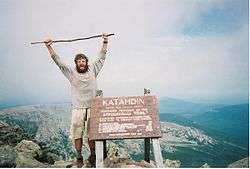Thru-hiking
Thru-hiking, or through-hiking, is to hike an established end-to-end hiking trail or long-distance trail with continuous footsteps in one direction.
In the United States, the term is most commonly associated with the Appalachian Trail (AT), the Pacific Crest Trail (PCT), and the Continental Divide Trail (CDT), but may also refer to other end-to-end hikes. Other examples of thru-hikes include the Te Araroa Trail in New Zealand, the Camino de Santiago in Spain, the Via Francigena in France and Italy, the Lycian Way in Turkey, the Israel National Trail, and the Great Divide Trail (GDT) in Canada.
The Appalachian Trail Conservancy defines a through-hike as one completed within a twelve-month period; this definition is used by many groups within the United States.
Section hiking, on the other hand, refers to hiking a trail one section at a time, without continuity and not necessarily in sequence with the other sections or within one hiking season.
History
Thru-hiking's origins date back many years, when long-distance foot travel as a means of transportation began to merge with hiking for its own enjoyment and as a means of seeing the world.
One famous thru-hike involves the story of Lillian Alling, a young 27-year-old Russian immigrant living in New York City. She became homesick and decided to return to her family in Russia. Lacking funds, but armed with a strong will, she chose to walk the 12,000 miles (19,000 km) to Russia, traversing Canada and into Alaska.[1] She was last seen preparing to cross by boat at the Bering Strait to Siberia.[1]
A thru-hiker named George W. Outerbridge completed the first section hike of the newly completed Appalachian Trail in 1939; trail promoter Myron Avery had previously section-hiked while trail blazing.
Earl Shaffer became the first to have publicly thru-hiked the AT in 1948.[2] A 1994 report claimed that a group of boy scouts had done so twelve years earlier, but these claims have never been adequately documented. Therefore, they are considered highly suspect in most hiking circles (see Appalachian Trail).
A number of thru-hikers have achieved a measure of celebrity in backpacking culture. Perhaps the most famous was Emma "Grandma" Gatewood, who first thru-hiked the Appalachian Trail in 1955 at age 67. She completed the hike with what, even at that time, was considered extremely inadequate gear, including sneakers rather than boots and a blanket rather than a sleeping bag;[3] she later completed a second thru-hike and a full section hike and is recognized today as a pioneer of ultralight backpacking.
Today

Thru-hiking a trail is a long and difficult journey: an AT thru-hike, for example, takes five months on average, covering 2,189.2 miles (3,523.2 km). A PCT or CDT thru-hike also entails several months of planning in order to prepare gear and re-supply points. These two trails also take 4–6 months to complete. Thru-hikers can organize supplies for the journey far in advance, and have friends and family mail packages to predetermined stops along the way, to be picked up as general delivery. These caches-via-mail are usually referred to as "supply boxes". The most popular method, however, is to resupply roughly every three to five days at a village or town that is close to the trail. This cuts down on unnecessary planning and offers a greater degree of flexibility.
The Continental Divide Trail does not have one official route. As of 2013, about 76% of the trail has been completed according to the CDT Coalition.
Many people choose to forego thru-hiking, due to time constraints or lack of desire, and instead section-hike a trail, completing it piece by piece, often over many years.
With the rise of backpacking in the United States, thru-hiking has become a minor industry. Thousands of hikers attempt to thru-hike the AT and other National Scenic Trails every year, although by some estimates fewer than 20% complete the trail. Roughly 150 end-to-end the (much shorter) Long Trail, and about 180 thru-hike the Pacific Crest Trail each year. Some dedicated thru-hikers complete a trail more than once; about 30 have reported hiking the AT at least three times. Lee Barry became the oldest to thru-hike the AT when he completed a thru-hike (his second) in 2004 at age 81.[4]
The Appalachian Trail Conservancy has reported completion rates around 25% in recent years, after several years under 20%.[5] They attribute this to slightly lower numbers of hikers, better gear, and, thanks to the internet, information about gear, causing fewer hikers to start with 60 to 80 pounds (27.2–36.3 kg) packs and drop out a few miles in.[5] Those long-distance hikers who have completed all three of the nation's longest National Scenic Trails: The Appalachian Trail, The Pacific Crest Trail and The Continental Divide Trail are known as Triple Crowners.[6] Base pack weight in this group of hikers is in the range of 10 to 15 pounds (4.5–6.8 kg).
See also
Further reading
- Lugo, Derick (2019) “The Unlikely Thru-Hiker: An Appalachian Trail Journey”, Publisher: Appalachian Mountain Club Books, ISBN 1628421185
- Bruce, Dan (2000) The Thru-Hiker's Handbook Hot Springs, North Carolina: Center for Appalachian Trail Studies.
- Norton, Russell (1997) Long Trail End-to-Ender's Guide. Waterbury Center, Vermont: Green Mountain Club.
- Shaffer, Earl V. (1983) Walking With Spring. Harper's Ferry, West Virginia: the Appalachian Trail Conference.
- Berger, Karen and Daniel Smith (1993). Where the Waters Divide: A Walk along America's Continental Divide. New York: Random House.
- Bryson, Bill (1998). A Walk in the Woods. Broadway Books.
References
- Calvin Rutstrum (2000), The New Way of the Wilderness: The Classic Guide to Survival in the Wild, Minneapolis, MN: University of Minnesota Press, ISBN 0-8166-3683-4
- Earl V. Shaffer (2004), Walking With Spring, Harpers Ferry, W. Va.: Appalachian Trail Conference, ISBN 0-917953-84-3
- Freeling, Elisa (November–December 2002), "When Grandma Gatewood hiked the Appalachian Trail", Sierra
- About the Trail – Noteworthy 2,000-Milers, Appalachian Trail Conservancy
- About the Trail – 2,000-Milers in Recent Years, Appalachian Trail Conservancy
- http://aldhawest.org/triple-crown/